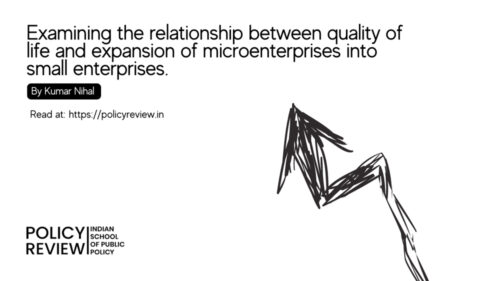
Examining the relationship between quality of life and the expansion of microenterprises into small enterprises

The growth of any region in India is closely linked to the growth of Micro, Small & Medium Enterprises (MSME). The share of MSME gross value added (GVA) in India’s gross domestic product (GDP) was 26.83% in 2020–21. The share of exports of specified MSME-related products in all of India’s exports was 49.35% in 2020–21. MSME is also a major source of employment. However, small and medium enterprises, which contribute significantly to the GDP, exports, and employment, account for less than 1% of MSMEs, while microenterprises comprise the remaining 99%. Manufacturing and service units with a turnover of up to Rs. 5 crore are classified as ‘micro’, while those with a turnover of up to Rs. 50 crore are classified as ‘small’.
Most of the microenterprises in India are family-owned. Transitioning from micro to small enterprises heavily depends on the entrepreneurial families that run the businesses. The desire of the younger generation in an entrepreneurial family to live in the place where they own the enterprise directly influences the efforts put in by them for its growth. Also, the desire to live in a place is highly dependent on the quality of life offered there.
Usually, it is observed that the younger generation in most of these families from places with poor quality of life, such as Bihar, migrates away to pursue academic and professional goals. They aspire to experience the quality of life provided by cities like Mumbai, Ahmedabad, and Chennai. The older generation of the family struggles to keep the business afloat in an era that demands dynamism and continuous modernisation. The business remains stunted due to this generational shift in the desire for quality of life, which is not an unfair ask. In contrast, the younger generation in most entrepreneurial families in places with a good quality of life, such as Mumbai (Maharashtra), Ahmedabad (Gujarat), and Chennai (Tamil Nadu), continue to stay there, despite having professional jobs. The youth in such families have a stronger incentive to work for the growth of their enterprises. This observation shows a correlation between the quality of life in a place and the growth of microenterprises into small enterprises there.
A comparative analysis of the Annual Report 2021–22 by the Ministry of MSME with the Ease of Living Index (EoLI) Report 2020 by the Ministry of Housing and Urban Affairs provides quantitative backing for this observation. The Quality of Life pillar in the EoLI evaluates cities based on the varied components of what is essentially a comfortable life in an urban space. Among the top ten million+ cities in this pillar, three are from Maharashtra and Gujarat, and two are from Tamil Nadu and Madhya Pradesh. Not even a single city from Bihar features in the top 40 in this pillar. It can be safely assumed that the quality of life in cities within a state is a general indicator of the quality of life in that entire state.
From the annual report of MSME, the total number of microenterprises and small enterprises is 26.74 lakh, 33.16 lakh, 34.46 lakh, 47.78 lakh, and 49.48 lakh for MP, Gujrat, Bihar, Maharashtra, and Tamil Nadu, respectively. The ratio of the number of microenterprises to the number of small enterprises can be safely correlated to the conversion of micro into small enterprises. The lower the ratio, the higher the growth of microenterprises into small enterprises. This ratio comes out to be 85, 65, 280, 234, and 190 for MP, Gujarat, Maharashtra, Tamil Nadu, and all of India, respectively. The lower ratio in MP and Gujarat can be attributed to the relatively fewer total enterprises in these states as compared to Maharashtra and Tamil Nadu. In contrast, for Bihar, despite having a higher number of enterprises than MP and Gujrat, the ratio comes out to be 860. Hence, this comparative analysis reaffirms the correlation between the quality of life in a place and the growth of microenterprises into small enterprises.
The growth of microenterprises into small enterprises is one of the best ways to fulfil our dreams over the years: a $5 trillion economy, the rise of Indian exports, employment generation, and inclusive and balanced regional growth. It will happen if the quality of life is improved in the underperforming states. The quality of life cannot be improved for the entire state in a short period, however, it can be improved for at least one or two cities in each state. It can provide a local alternative to the migrating younger generation in entrepreneurial families. This will provide a stronger incentive to stay in their state and work towards the growth of their enterprises, resulting in the India of our dreams.
FAQs
What are MSME?
The growth of any region in India is closely linked to the growth of Micro, Small & Medium Enterprises (MSME). They are also a major source of employment. However, small and medium enterprises, which contribute significantly to the GDP, exports, and employment, account for less than 1% of MSMEs, while microenterprises comprise the remaining 99%.
What is causing family businesses to stay afloat in the modern era?
It is observed that the younger generation with poor quality of life, migrates away to pursue academic and professional goals. They aspire to experience the quality of life provided by the cities like Mumbai, Ahmedabad, and Chennai. The older generation of the family struggles to keep the business afloat in an era that demands dynamism and continuous modernisation.
Why is the growth of microenterprises into small enterprises of crucial in India?
The growth of microenterprises into small enterprises is one of the best ways to fulfill our dreams over the years: a $5 trillion economy, the rise of Indian exports, employment generation, and inclusive and balanced regional growth. It will happen if the quality of life is improved in the underperforming states. The quality of life cannot be improved for the entire state in a short period, however, it can be improved for at least one or two cities in each state. It can provide a local alternative to the migrating younger generation in entrepreneurial families. This will provide a stronger incentive to stay in their state and work towards the growth of their enterprises, resulting in the India of our dreams.

